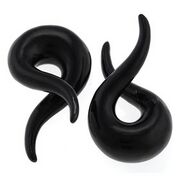Horn
Jump to navigation
Jump to search
Horn is an organic material composed primarily of keratin, the same material the human body uses to build hair and nails. Large mammals typically have commonly harvested head protrusions in one of three categories: horns, tusks or antlers.
Antlers differ from horns and tusks in that they are composed of bone, and are grown and shed by the animal on a yearly basis. Tusks differ from horns and antlers in that they are simply large overgrown teeth and are composed of enamel and dentin.
Horn, particularly water buffalo horn, is often carved into body jewelry.
